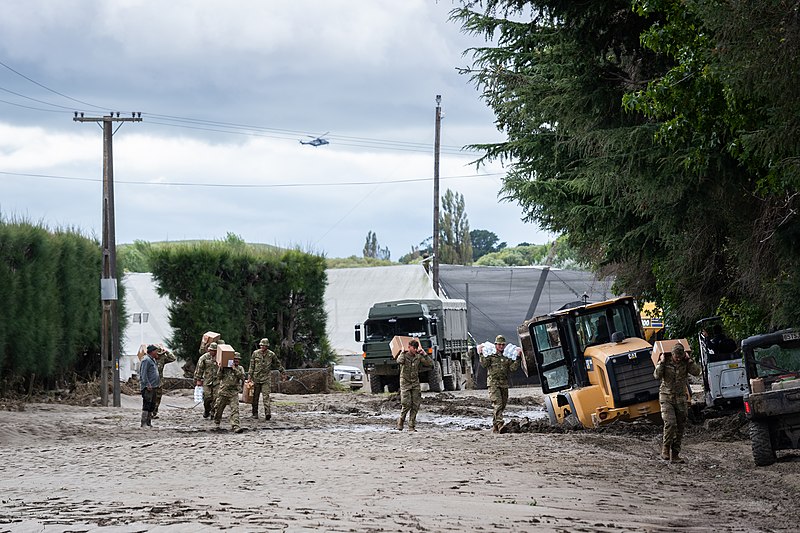An independent review highlights the need to recognise marae as “vital providers of community intelligence and services,” and recommends formalising iwi/Māori involvement in Civil Defence Emergency Management structures.
The report also found that the Hawke’s Bay Civil Defence and Emergency Management group was not prepared for Cyclone Gabrielle, and the “worst case scenario” was not planned for.
The full report and accompanying media release are available here.
The SMC asked independent experts to comment.
Professor Christine Kenney PhD, Chair of Disaster Risk Reduction at Massey University, comments:
“The review of Hawke’s Bay Civil Defence and Emergency Management Group’s response to Cyclone Gabrielle highlights the consistently effective response by local Iwi, hapū and whānau to the cyclone’s impacts, a response informed by “deep knowledge of the behaviour of the region’s waterways and lands”. In contrast, CDEM and local government’s pattern of ad hoc engagement with regional iwi and Māori communities, is showcased as detrimental to effective emergency management within the Hawke’s Bay. Formalisation of engagement with Taiwhenua, local marae and Māori communities to facilitate collaborative disaster readiness, risk mitigation, response and recovery planning is strongly recommended. The report also advocates for Māori emergency management training and delegations that support devolving welfare and service delivery decisions and accountabilities to local Māori responders, with a view to ensuring well-coordinated, ‘all of community’ responses to catastrophic hazard events.
“These recommendations mirror those repeatedly presented in reviews of past emergency management responses, notably the 2020 Covid pandemic, 2019 Nelson/Tasman Fires, as well as the 2016 Kaikoura and 20210-2011 Canterbury earthquakes. Yet to be implemented, these earlier recommendations informed the previous government’s development of the 2023 Emergency Management Bill. Currently in Select Committee and awaiting it’s second reading, the bill addresses most recommendations pertaining to tangta whenua noted in the ‘Response to Cyclone Gabrielle’ Report, as well as Māori perceptions that “their proven abilities to deliver welfare services at scale are either ignored or hampered by bureaucratic decision making from the centre”, again a statement common to previous reviews of past responses.
“Given the regional focus of the report, mana whenua provided most of the commentary and the importance of formally engaging with tangata whenua nationally, was not explored in detail. Yet, the Māori response to the impacts of Cyclone Gabrielle was rapidly nationalised with multiple iwi, hapū, whānau and Māori organisations, mobilising assets, and resources to support communities. As the Māori asset base, conservatively estimated at $70 billion dollars, has, and will be mobilised again in response to natural hazard and other disasters, implementing the report’s recommendations pertaining to tangata whenua may be key to effective emergency management in the future.
“The report also suggests Australia’s emergency management system as a potential template for informing needed changes within New Zealand’s nationwide infrastructure. Considering a country continent with the resources that Australia can draw upon in relation to a small multi-island Pacific state such as New Zealand could be construed as a comparing ‘apples with oranges’ scenario. However, community-led emergency management approaches such as those instituted by tangta whenua, mobilise in both nations in response to adversity, and there may be lessons to learn. Regardless, moving forward, a central consideration for the New Zealand government will be ensuring that changes to national and local emergency management operations are contextually relevant, and that will require comprehensive engagement with Māori at every level of the emergency management infrastructure within Aotearoa.”
Conflict of interest: “None, but I am a member of the Ministerial Advisory Committee on Emergency Management.”
Dr Shaun Awatere, Kaihautū Māori Research Impact Leader, Manaaki Whenua – Landcare Research, comments:
“Māori researchers argue that Māori world views and practices can serve as a complementary way of seeing reality, one that is able to work harmoniously with Western views with the right approaches and interfaces. It is heartening to see the leadership taken by the Independent Review Panel in recommending that a Disaster Reduction Plan for Hawke’s Bay is informed by mana whenua contributions to risk reduction, disaster readiness, response, recovery and community resilience.
“A business as usual approach is often easier to put into practice, with its rigid and clearly delineated components. The holistic and relational aspects of a te ao Māori approach to disaster risk reduction make it much messier and more complex to operationalise. Yet, there are numerous projects, particularly in sustainability areas, where te ao Māori approaches have been operationalised with great success; the arguments against are nothing compared to the difficulties we will face in coming years if risk and vulnerability to extreme weather and climate change hazards are not reduced and community resilience built up.”
Conflicts of interest: None declared
